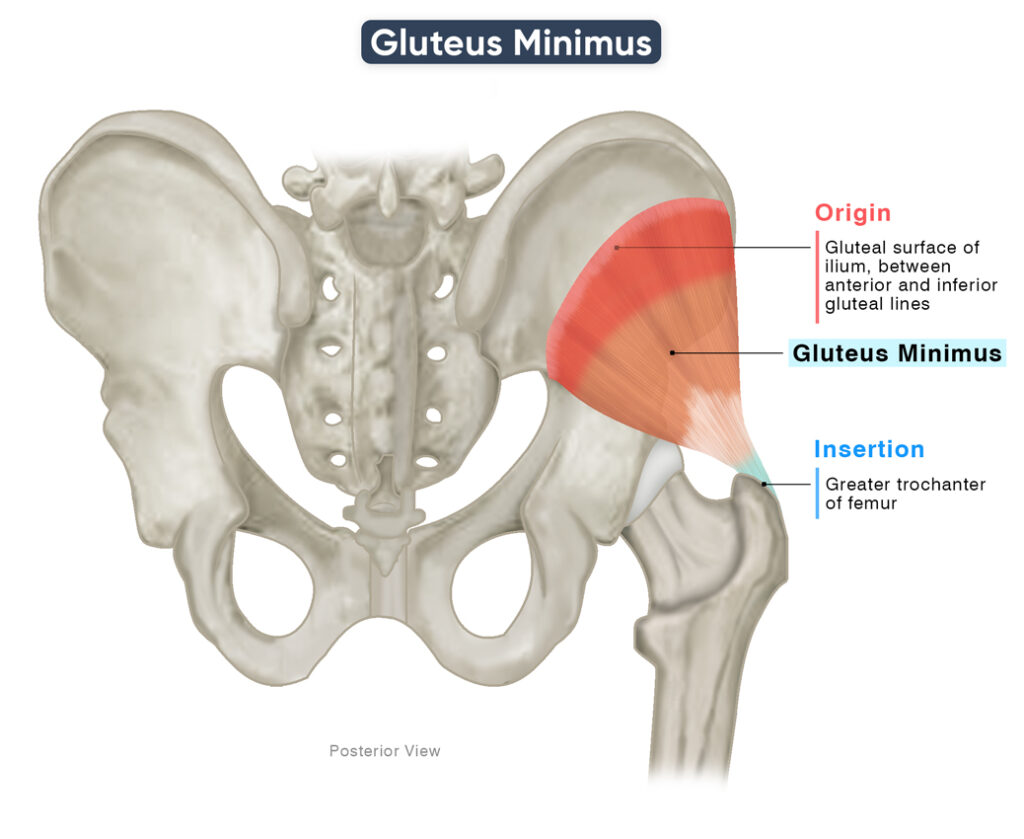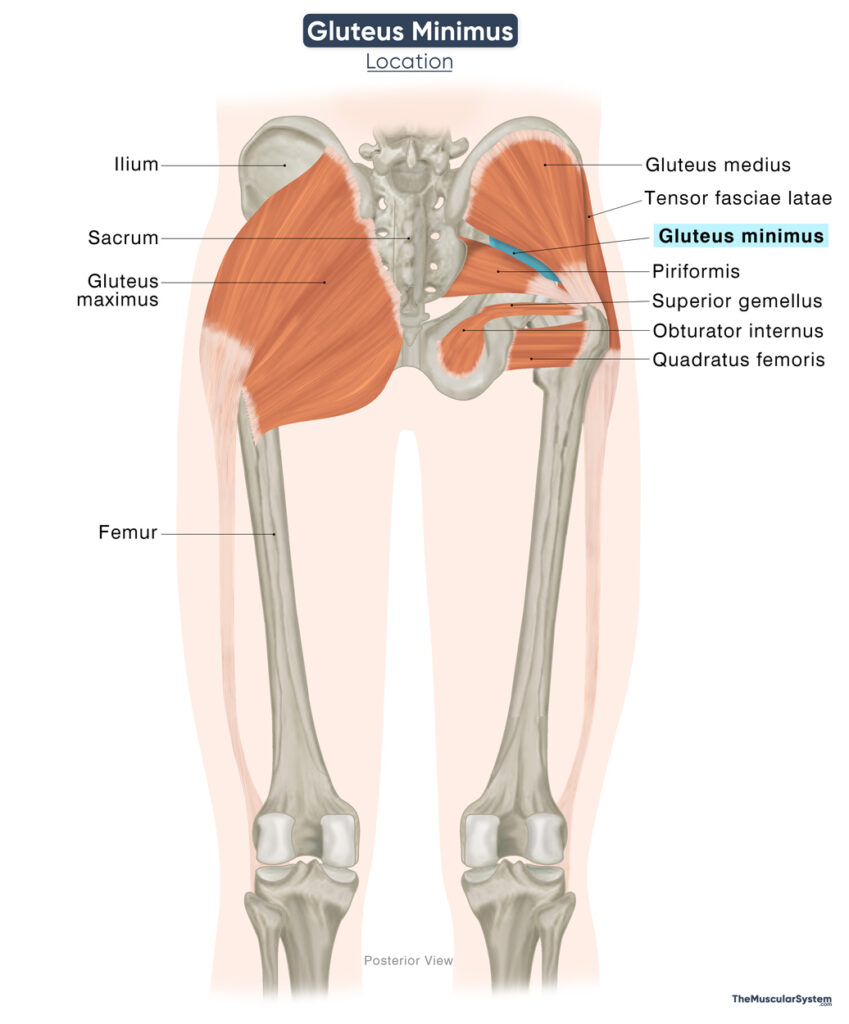Gluteus Minimus
Last updated:
14/08/2025Della Barnes, an MS Anatomy graduate, blends medical research with accessible writing, simplifying complex anatomy for a better understanding and appreciation of human anatomy.
What is the Gluteus Minimus
The gluteus minimus is the smallest and deepest of the three gluteal muscles. Like the gluteus medius, it has a fan-shaped appearance and lies on the outer surface of the ilium. It belongs to the group of medial rotators and abductors of the thigh and helps with keeping the pelvic region stable during movements.
Anatomy
Location and Attachments
| Origin | The gluteal surface of the ilium, between the anterior and inferior gluteal lines |
| Insertion | Greater trochanter of the femur |
Origin
The gluteus minimus originates from a broad area on the gluteal surface of the ilium, between the anterior and inferior gluteal lines. Additionally, some fibers may arise from the outer margin of the greater sciatic notch, near the point where the inferior gluteal line begins.
Insertion
The muscle fibers converge into a narrow, flat tendon, giving the muscle its characteristic fan-shaped appearance. This tendon courses laterally downward, crossing the hip joint capsule to insert onto the anterior surface of the greater trochanter of the femur.
Relations With Surrounding Muscles and Structures
It is the deepest of the superficial muscles in the gluteal (buttock) region, lying beneath the gluteus maximus, gluteus medius, and tensor fasciae latae. Although smaller in size, its shape and appearance resemble those of the gluteus medius, which completely covers its posterior surface. The deep branches of the superior gluteal artery and nerve course between these two muscles, running along the superficial surface of the gluteus minimus.
The piriformis muscle lies along the lower border of the gluteus minimus. In some anatomical variations, fibers of the gluteus minimus may blend with the piriformis or the superior gemellus, though this is uncommon.
Proximally, the muscle lies superficial to the ilium, while distally, it overlies the hip joint capsule and the reflected head of the rectus femoris.
A small bursa, sometimes called the trochanteric bursa of the gluteus minimus, is located between the tendon of the muscle and the greater trochanter. This bursa reduces friction as the muscle moves over the hip joint during activity.
Function
| Action | Stabilizing the pelvis; abducting, and internally rotating the thigh |
Like its appearance, the functions of the gluteus minimus also mirror those of the gluteus medius.
Abducting the thigh
When the muscle contracts, it works in synergy with the gluteus medius and tensor fascia lata to move the thigh and the lower limb away from the midline of the body. The simplest example of this is the movement you make when you step sideways.
Rotating the thigh medially
As part of the medial rotator group, its anterior fibers contract to pull on the head of the femur and rotate the leg medially, or inwards, toward the other leg.
Stabilizing the pelvis and hip joint
With its attachments at the ilium and the hip joint, this muscle plays an important role in maintaining the stability of the pelvis and the hip joint during movements like walking and running. During walking, when one leg is off the ground (swing phase of gait cycle), the gluteus minimus on the stance side contracts to prevent the pelvis from tilting downwards on the unsupported (swing) side.
Antagonists
It works against the lateral rotators, including the piriformis, obturators, and quadratus femoris, during medial rotation of the thigh. Additionally
As a hip abductor, the gluteus medius is opposed by the hip adductors, adductor longus, brevis, magnus, gracilis, and pectineus, which draw the thigh toward the midline.
Innervation
| Nerve | Superior gluteal nerve (L4-S1) |
It is innervated by the superior gluteal nerve, originating from the posterior divisions of the L4, L5, and S1 nerves of the sacral plexus.
Blood Supply
| Artery | Superior gluteal artery |
The muscle’s main blood supply comes from the superior gluteal artery, a terminal branch of the posterior division of the internal iliac artery.
The muscle’s tendon also receives blood from the trochanteric anastomosis, which is formed by the superior and inferior gluteal arteries and the ascending branches of the lateral and medial circumflex femoral arteries.
References
- Gluteus Minimus: TeachMeAnatomy.info
- Anatomy, Bony Pelvis and Lower Limb, Gluteus Minimus Muscle: NCBI.NLM.NIH.gov
- Gluteus Minimus Muscle: Kenhub.com
- Gluteus Minimus Muscle: Elsevier.com
- Gluteus Minimus – Attachments, Actions & Innervation:GetBodySmart.com
- Gluteus Minimus Muscle: IMAIOS.com
- Gluteus Minimus Muscle | Location, Action & Function: Study.com
- Muscles of the Gluteal Region: TeachMeAnatomy.info
Della Barnes, an MS Anatomy graduate, blends medical research with accessible writing, simplifying complex anatomy for a better understanding and appreciation of human anatomy.
- Latest Posts by Della Barnes, MS Anatomy
-
Thyrohyoid
- -
Suprahyoid Muscles
- -
Geniohyoid
- All Posts







